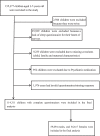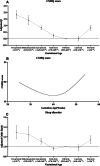Associations between gestational age and childhood sleep: a national retrospective cohort study
- PMID: 35934710
- PMCID: PMC9358861
- DOI: 10.1186/s12916-022-02443-9
Associations between gestational age and childhood sleep: a national retrospective cohort study
Abstract
Background: Both sleep quality and quantity are essential for normal brain development throughout childhood; however, the association between preterm birth and sleep problems in preschoolers is not yet clear, and the effects of gestational age across the full range from preterm to post-term have not been examined. Our study investigated the sleep outcomes of children born at very-preterm (<31 weeks), moderate-preterm (32-33 weeks), late-preterm (34-36 weeks), early-term (37-38 weeks), full-term (39-40 weeks), late-term (41 weeks) and post-term (>41 weeks).
Methods: A national retrospective cohort study was conducted with 114,311 children aged 3-5 years old in China. Children's daily sleep hours and pediatric sleep disorders defined by the Children's Sleep Habits Questionnaire (CSHQ) were reported by parents. Linear regressions and logistic regression models were applied to examine gestational age at birth with the sleep outcomes of children.
Results: Compared with full-term children, a significantly higher CSHQ score, and hence worse sleep, was observed in very-preterm (β = 1.827), moderate-preterm (β = 1.409), late-preterm (β = 0.832), early-term (β = 0.233) and post-term (β = 0.831) children, all p<0.001. The association of pediatric sleep disorder (i.e. CSHQ scores>41) was also seen in very-preterm (adjusted odds ratio [AOR] = 1.287 95% confidence interval [CI] (1.157, 1.433)), moderate-preterm (AOR = 1.249 95% CI (1.110, 1.405)), late-preterm (AOR = 1.111 95% CI (1.052, 1.174)) and post-term (AOR = 1.139 95% CI (1.061, 1.222)), all p<0.001. Shorter sleep duration was also found in very-preterm (β = -0.303), moderate-preterm (β = -0.282), late-preterm (β = -0.201), early-term (β = -0.068) and post-term (β = -0.110) compared with full-term children, all p<0.01. Preterm and post-term-born children had different sleep profiles as suggested by subscales of the CSHQ.
Conclusions: Every degree of premature, early-term and post-term birth, compared to full-term, has an association with sleep disorders and shortened daily sleep duration. Preterm, early-term, and post-term should therefore all be monitored with an increased threat of sleep disorder that requires long-term monitoring for adverse sleep outcomes in preschoolers.
Keywords: Children’s sleep habit questionnaire; Daily sleep duration; Gestational age; Preschoolers; Sleep disorder.
© 2022. The Author(s).
Conflict of interest statement
The authors declare that they have no competing interests.
Figures



Similar articles
-
Comparison of sleep problems between term and preterm born preschool children.Sleep Med. 2020 Nov;75:484-490. doi: 10.1016/j.sleep.2020.09.013. Epub 2020 Sep 17. Sleep Med. 2020. PMID: 33010574
-
Association of Gestational Age at Birth With Subsequent Suspected Developmental Coordination Disorder in Early Childhood in China.JAMA Netw Open. 2021 Dec 1;4(12):e2137581. doi: 10.1001/jamanetworkopen.2021.37581. JAMA Netw Open. 2021. PMID: 34905005 Free PMC article.
-
Association of Late Preterm Birth and Size for Gestational Age With Cardiometabolic Risk in Childhood.JAMA Netw Open. 2022 May 2;5(5):e2214379. doi: 10.1001/jamanetworkopen.2022.14379. JAMA Netw Open. 2022. PMID: 35622362 Free PMC article.
-
Systematic review suggests a relationship between moderate to late preterm birth and early childhood caries.Acta Paediatr. 2020 Dec;109(12):2472-2478. doi: 10.1111/apa.15424. Epub 2020 Jul 8. Acta Paediatr. 2020. PMID: 32559323
-
Health outcomes in infancy and childhood of moderate and late preterm infants.Semin Fetal Neonatal Med. 2012 Jun;17(3):159-62. doi: 10.1016/j.siny.2012.02.002. Epub 2012 Mar 13. Semin Fetal Neonatal Med. 2012. PMID: 22417643 Review.
Cited by
-
Sleep problems from age two to five years and neurological outcome in children born extremely preterm: a cross-sectional study.Front Pediatr. 2025 Jul 9;13:1562630. doi: 10.3389/fped.2025.1562630. eCollection 2025. Front Pediatr. 2025. PMID: 40726904 Free PMC article.
-
The association between maternal sleep and circadian rhythms during pregnancy and infant sleep and socioemotional outcomes.Eur Child Adolesc Psychiatry. 2025 Apr;34(4):1365-1377. doi: 10.1007/s00787-024-02571-y. Epub 2024 Aug 24. Eur Child Adolesc Psychiatry. 2025. PMID: 39180688
-
Prevalence of Sleep Disorder in Chinese Preschoolers: A National Population-Based Study.Nat Sci Sleep. 2022 Nov 24;14:2091-2095. doi: 10.2147/NSS.S383209. eCollection 2022. Nat Sci Sleep. 2022. PMID: 36452478 Free PMC article.
-
Associations of preterm and early-term birth with suspected developmental coordination disorder: a national retrospective cohort study in children aged 3-10 years.World J Pediatr. 2023 Mar;19(3):261-272. doi: 10.1007/s12519-022-00648-9. Epub 2022 Dec 5. World J Pediatr. 2023. PMID: 36469242 Free PMC article.
-
Association between postterm birth and adverse growth outcomes in children aged 3-6 years: A national retrospective cohort study.Paediatr Perinat Epidemiol. 2025 Jan;39(1):30-40. doi: 10.1111/ppe.13122. Epub 2024 Sep 19. Paediatr Perinat Epidemiol. 2025. PMID: 39297305 Free PMC article.
References
-
- Mindell JA, Owens JA. A clinical guide to pediatric sleep: diagnosis and management of sleep problems. 3. Philadelphia: Wolters Kluwer/Lippincott Williams & Wilkins; 2015.
Publication types
MeSH terms
LinkOut - more resources
Full Text Sources
Medical

